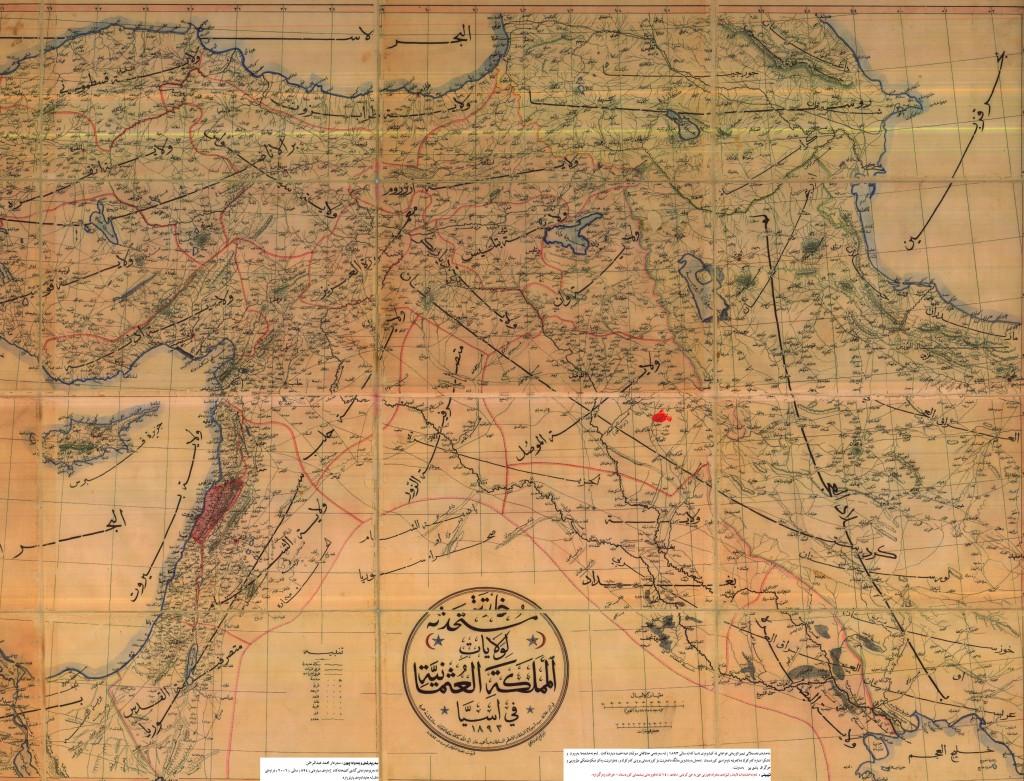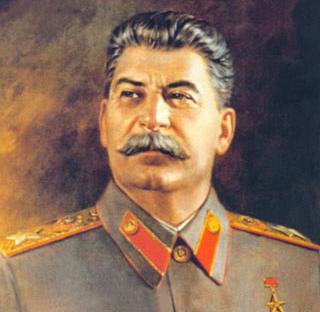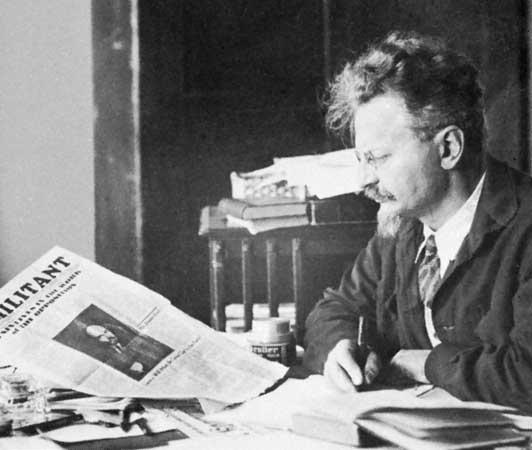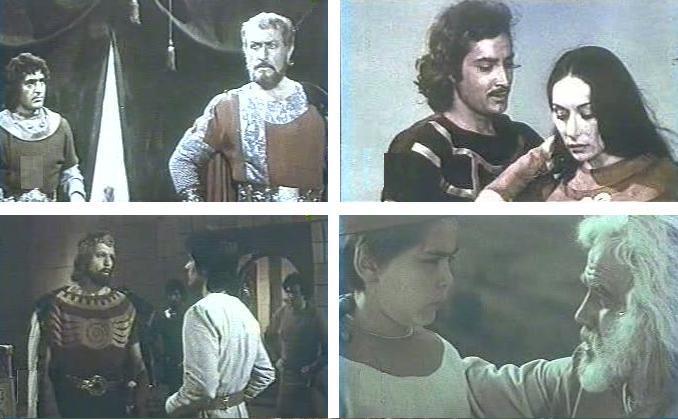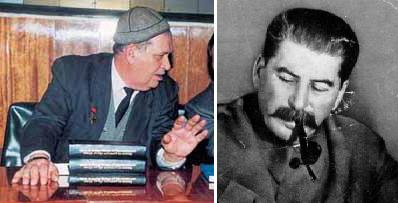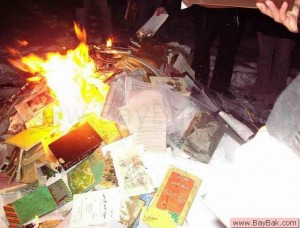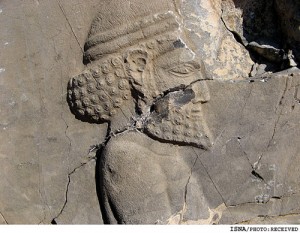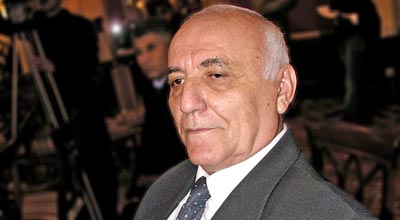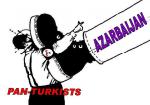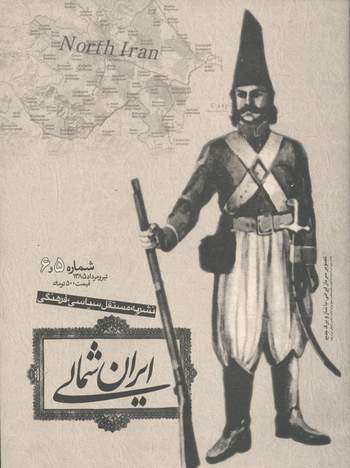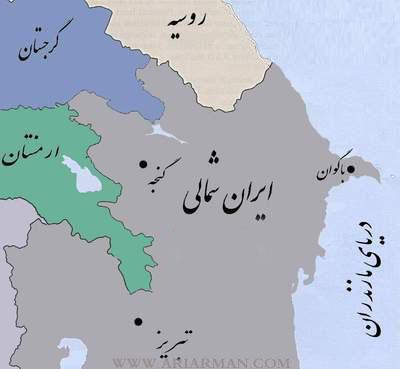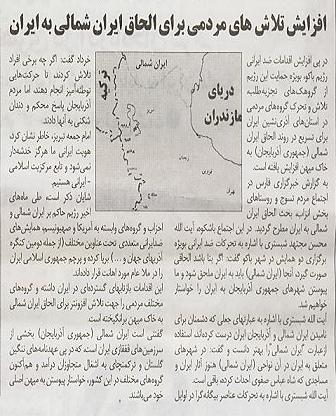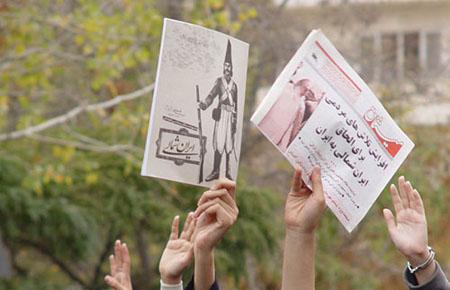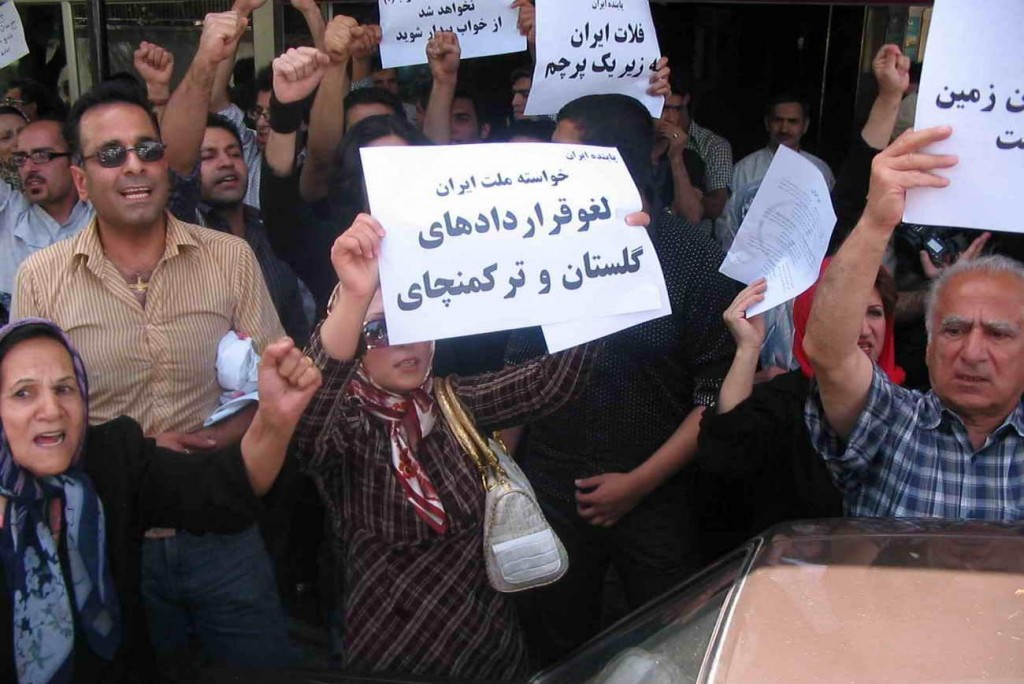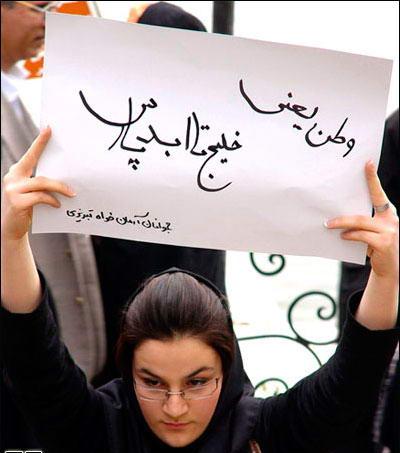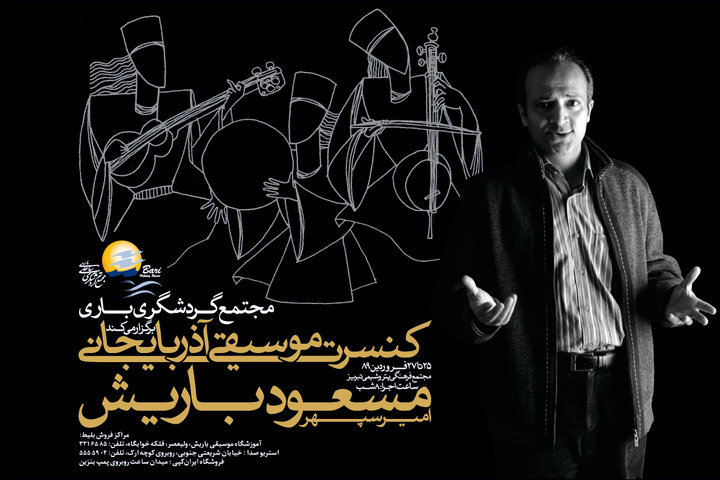Question 6: After the end of the “Democrat affair” in 1946 we do not hear anymore of the story of “North and South Azarbaijan” until 1990 with the collapse of the Soviet Union. What is the role of the government of Baku in promoting pan-Turkism?
– پس از پایان «غائلهی فرقه» در سال ۱۹۴۰ دیگری خبری از داستان آذربایجان شمالی و جنوبی نیست تا این که در سال ۱۹۹۰ اتحاد شوروی فروپاشید. نقش دولت باکو در گسترش ایدئولوژی پانترکیسم چیست؟
Kaveh Farrokh: Before we begin, I would like to take this opportunity to introduce readers to a new book entitled “Pan-Turkism: Iran and Azarbaijan” by Mohammad-Reza Mohseni (with the foreword by Dr. Houshang Tale): For more information on ordering this book please consult: http://mrmohseni.blogsky.com/ The above book also documents the role of the government of Baku is promoting pan-Turkist ideology in Iran.
The 1979 Revolution: Pan-Turks use the chaos to enter Iran
The pan-Turkism issue was essentially dead until the arrival of the 1979 revolution. The state of political flux allowed a number of exiled Tudeh members (both mainstream and those of the Pishevari movement) to arrive into Iran and Tabriz in particular. These were essentially moles, quietly re-entering Tabriz and Azarbaijan to slowly begin spreading their messages of secession, Persophobia and pan-Turkism to a new generation. Just after the conclusion of the revolution in February 1979, close to 4000 hard core pan-Turks of the discredited Pishevari Soviet-controlled government crossed the border of Soviet Azarbaijan (Arran until 1918) into northwest Iran’s Azarbaijan province. The details of this were discussed in the BBC-Persian report of February 9, 2011. Some the revelations made in the BBC report are of interest – below is an excerpt:
. در روزهای ابتدایی تغییر رژیم پادشاهی که مرزهای ایران به روی همه باز بود و کنترلی در کار نبود، تعداد قابل توجهی از باقی ماندگان فرقه دموکرات آذربایجان و بعضی از فرزندان آنها برای پیوستن به سایر چپ های طرفدار شوروی، به تعداد چهار هزار و ۵۰۰ نفر از طریق مرزهای شمالی وارد ایران شدند و در سرتاسر کشور پخش شدند Translation: During the early days of the former Pahlavi regime’s overthrow, Iran’s borders were virtually unguarded. This allowed for a substantial number of the remnants of the Ferqeh Democrat Azarbaijan and some of their children to join other like-minded pro-Soviet leftist groups inside Iran. A total of 4,500 of these crossed into Iran’s northern borders to then spread out across Iran.
By the late 1980s, events on the world stage were to also help re-ignite the pan-Turkist movement. In June 1989 a number of academics, politicians and cultural activists gathered in Baku to form the People’s Front of Azarbaijan (PFA). From the outset they demanded that all borders between their republic (which had not yet become independent) and Iranian Azarbaijan be removed. By late 1989, a group of activists in Nakhchevan stormed the border posts and removed these in a symbolic act of reunification. On the surface these events seemed very positive for Iran – on Television it looked as if the sons and daughters of a lost Iranian province were yearning to join their lost homeland – Iran. But this was far from the case. Thanks to decades of Communist brainwashing, the Arranis never realized that they were in fact a former Iranian province. Instead they believe to this day that there was some mythical “Greater Azarbaijan” that had been divided between Iran and Russia as a result of the 19th century Golestan and Turkmenchai treaties. It was this very policy that moved the political platform of the PFA. The latter held numerous forums in which activists spoke against the territorial integrity of the Iranian state. Meanwhile events in the Soviet Union had deteriorated as more and more of its territory and former Iranian provinces slipped out of its control. In January 1991 Moscow sent its army to brutally suppress the political activists there in a bid to re-assert Russian domination. But it was already too late. By late August 1991 a failed coup in Moscow had left the Communists of the Soviet Union in a state of confusion and chaos.
The role of President Abulfazl Elchibey (1938-2000)
The impact of this confusion was felt by the local Baku communists led by Ayaz Mutallibov. By late August the formal call for complete independence from the Soviet Union was finally ratified by the local Communists – with Mutallibov still as president. By June 1992, the situation had again changed. Political chaos had led to the resignation of Mutallibov as president. He was replaced by Abulfazl Elchibey as president of the newly independent “Republic of Azarbaijan”. From the outset Elchibey expressed his open hatred for Iran as a state. He passionately believed in the Russo-Soviet and pan-Turk historical fabrications – especially the notion of a “Greater Azarbaijan”. His speeches often made clear his desire to see Iranian Azarbaijan separate from Iran to join the Republic of Azarbaijan. From the viewpoint of the Iranians, not much had changed – Elchibey was simply chanting the same rhetoric as that of the Musavats, pan-Turks, the Communists and the former Soviet Union. In a sense, Elchibey was the political reincarnation of Mir Jaafar Bagherov. Elchibey failed. Like Bagherov, Elchibey was so brainwashed that he did not realize that his calls for a Greater Azarbaijan would receive a cool reception among Iran’s Azarbaijani population. His main support came from small cells of Iranians who continue to work closely with western lobbies and Tel Aviv. Elchibey did not last long – just one year later in June 1993, he was overthrown by Heidar Aliev. Even after he was removed from office in Baku, Elchibey continued his tragic tirades against Iran and her people. Note the below excerpts from Elchibey’s speech at the Fifth Kurultai(lit. Congress) of the Popular Front of Azerbaijan Party, on 30-31 January 1998, in Turkey:
“The creation of the Azerbaijan Democratic Republic in the Northern Azerbaijan on some of Azerbaijani lands in 1918-1921, and its restoration…in 1991, does not mean that the Azerbaijan national liberation movement is over. … The new stage will end with the creation and or restoration of a united Azerbaijani statehood. … Already in Iran there are active organizations, whose sole purpose is the state independence of the Azeri Turks.”
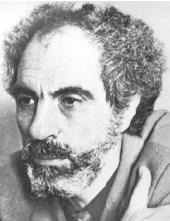
The late president Abul-Fazl Elchibey (1938-2000) of the Trans-Caucasian Republic of Azarbaijan (First named as such in 1918). Elchibey often expressed his open dislike of Iran and the Iranian people. In a total lack of diplomatic tact, Elchibay repeatedly demanded that Iran be partitioned in favor of a “Greater Azarbaijan”.
Elchibey ‘s Legacy and the Falsification of History
As we already noted, the historical fiction of a “North” and “South” Azerbaijan was invented by the Soviets of Moscow and Baku. The notion of annexing Iran was completely discredited after the collapse of the Pishevari puppet regime in 1946. What proved especially embarrassing to the Communists of Moscow and Baku were the cheering Azarbaijanis greeting the Iranian army as liberators. 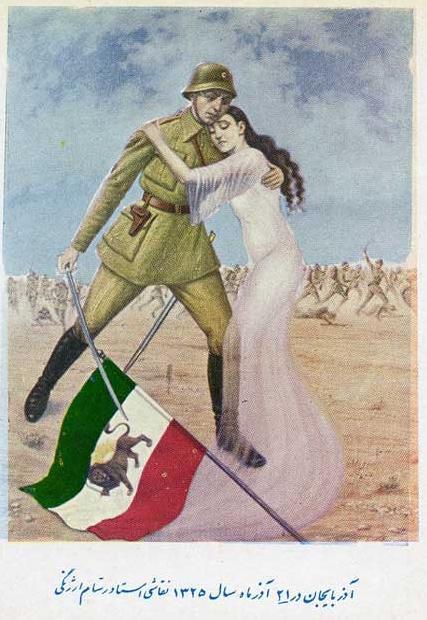 A symbolic Iranian painting portraying Azarbaijan embracing the Iranian army as it chases pro-Moscow Communist separatists into the former Soviet Union. Numerous on-the-ground reports by western observers noted that Iranian Azarbaijanis provided a warm and enthusiastic welcome to the Iranian army as it cleared Azarbaijan province of Moscow-Baku funded separatists. Unfortunately these historical facts have been denied to the populace of the modern Republic of Azarbaijan (known as Arran/Albania and the Khanates before 1918). Dr. Nazrin Mehdiyova (originally from the Republic of Azarbaijan) has noted that
A symbolic Iranian painting portraying Azarbaijan embracing the Iranian army as it chases pro-Moscow Communist separatists into the former Soviet Union. Numerous on-the-ground reports by western observers noted that Iranian Azarbaijanis provided a warm and enthusiastic welcome to the Iranian army as it cleared Azarbaijan province of Moscow-Baku funded separatists. Unfortunately these historical facts have been denied to the populace of the modern Republic of Azarbaijan (known as Arran/Albania and the Khanates before 1918). Dr. Nazrin Mehdiyova (originally from the Republic of Azarbaijan) has noted that
“…As a result
[of Soviet manipulation of history], the myth [of a Greater Azarbaijan] became deeply ingrained in the population [of the Republic of Azarbaijan] and was adopted by the PFA [Popular Front of Azerbaijan] as part of the rhetoric.” (Mehdiyova, 2003, p.280).A video of the late president Abul-Fazl Elchibey (1938-2000) making a speech on December 31, 1999. In what can be termed as selective historical amnesia. Elchibey lumps Sheikh Mohammad Khiyabani, Mohammad Amin Rasulazadeh and Mirjaafar Pishevari as “Azarbaijani heroes”. In realtiy, Sheikh Khiyabani resented Rasulazadeh’s appropriation of the name “Azarbaijan” for the newly founded 1918 “Republic of Azarbaijan” in the Caucasus – an entity that had never existed in history. Khiyabani in fact rejected Rasulzadeh’s pan-Turkism and was clear that the historical Azarbaijan in Iran was an integral part of Persia. As per Pishevari being a “hero” this too is a gross misrepresentation: the vast majority of Iranian Azarbaijanis rejected Pishevari as a traitor and a stooge of the Soviet Union. The late president Elchibey was one of the many tragic victims of Tsarist and Soviet era ethno-cultural engineering.
It was Iranian-Azari scholar Dr. Shireen Hunter who first raised the alarm with Baku’s irredentist propaganda as well as its role in promoting Stalin-era historical falsifications. Note the exceprt from Dr. Hunter’s 1998 text below (Iran and Transcuacsia in the Post-Soviet Era” Daṿid Menashri,”Central Asia meets the Middle East, Psychology Press, 1998, pp 106-107):
As far as the Transcaucasian states are concerned, the impact of this historic legacy has differed from country to country. In their case, too, considerations other than the historic factors have played a more important role at the policy level in determining their relations with Iran. By and large, the historic links had a positive impact on Iranian-Armenian, and to some extent, on Iranian-Georgian relations. In the case of Azerbaijan, this historic legacy has had, on balance, a negative impact on its relations with Iran. Indeed, Iran’s relations with Azerbaijan have been more complicated and emotionally charged than its ties with the other two Transcaucasian states. The emotional and political intensity of their relations reflects, in part, the inherent and inevitable tensions between the Iranian and Turkic dimensions of their origins and culture which exist in the Republic of Azerbaijan, and to a lesser extent, in the Iranian province of Azerbaijan. In the Republic of Azerbaijan, the long Soviet practice of historic falsification has left a legacy which has distorted both the views of many Azerbaijanis of Iran and the true nature of their cultural, ethnic and historic connections. The following are some examples of this process of falsification, which, incidentally, in the last few years, has been picked up and given new credence by a number of Western commentators. Several myths with significant policy implications shape the Azerbaijanis’ views of their country, its origins, and its relations to Iran. The first myth is that there was an ancient Azerbaijani state which incorporated most of what is currently northern Iran. Yet, historically, the Republic of Azerbaijan was not known by this name until 1918, when Ottoman troops established the Musavatist government there and affixed the name of Azerbaijan to it. This prompted some Iranian Azerbaijani to want to change the name of their province into ‘Azadestan’, because they feared that the Ottomans, who still coveted Iranian Azerbaijan, would use the common name in order to justify the unification of the two provinces under Ottoman tutelage. Considering that during this period Ottoman troops occupied part of Iran, the Iranian fears were not unjustified. After the Ottoman empire had collapsed, both the Communists and, later, the Azerbaijani nationalists developed the myth of one Azerbaijan divided into a southern and northern part, comparing it to what happened to the two Germanics and to Korea, and using this myth to justify irredentist claims toward Iranian territory. The second myth is that the division of united and ancient Azerbaijan into two separate regions was the result of a Russo-Iranian conspiracy. The historic fact, however, is that after devastating defeats at the hands of the Russians, Iran had to cede territories to the Czar. Indeed, the second round of the Russo-Iranian wars in 1824 started because of the complaints of the Azerbaijani Muslims to the Iranian Shah that their fellow-Muslims, who had fallen under Russian control were being mistreated by the Russians. It is difficult to see how a country can conspire to lose part of its territory and to lose blood and treasure in the process. The third myth is that the Persians colonized and oppressed the Azerbaijanis. Yet the pattern of the population movement indicates that it was the Turkic incursions that changed the ethnic and linguistic character of this region. Thus, it was the indigenous Iranian peoples who were linguistically colonized as a result of Turkic invasions. Despite these myths, the historical and cultural elements of which the ex-Soviet Azerbaijani are most proud, such as being the land of Zoroaster and the poet Nizami, have distinctly Iranian origins and character. Ironically, the realization of this fact, rather than bringing the ex-Soviet Azerbaijanis closer to Iran, has had the opposite effect. This is because Azerbaijanis feel that the Iranian connection would hamper the development of an independent Azerbaijani identity — and, as far as some are concerned, a purely Turkic identity. However, even the most ardent pan-Turkists are aware – as indeed were the Communists – of the historic falsity of their views. They freely admit this in private and argue that the reason for their continued promotion of these themes is to help strengthen nationalist feelings and to forge a purely Turkic Azerbaijani identity.” Shireen T. Hunter, “Iran and Transcaucsia in the Post-Soviet Era” Daṿid Menashri,”Central Asia meets the Middle East”, Psychology Press, 1998, pp 106-107.
Below are examples of how Baku has engaged in the falsification of history. Falsifying History Books Nazrin Mehdiyova a historian from the Republic of Azarbaijan (ROA), has noted that
“…for the purpose of breaking Azerbaijan’s historical links with Iran… Soviet authorities falsified documents and re-wrote history books…” (Mehdiyova, 2003, p.280).
The policy of -re-writing history books and falsifying documents has continued to the present day by the Baku authorities. Despite the historical facts, a number of historical revisionist views are officially taught as “history” at the elementary, secondary and post-secondary levels of the educational system in the Republic of Azarbaijan (Former Arran as opposed to historical Azarbaijan in Iran). It is also no secret that the teaching of history in the Republic of Azarbaijan is distorted with respect to its Iranian historical ties and legacy:
سرنوشت غمبار تاریخ جمهوری آذربایجان اران در بیخبری ما + لینک دانلود فیلم
Even children’s textbooks in Baku have became a major medium for the transmission of Soviet/pan-Turkist ethno-nationalist propaganda. For more on this topic consult a recent textbook entitled “Ata Yurdu” now being taught in Baku’s schools:
–تبلیغات ضد ایرانی در کتابهای درسی رژیم حاکم بر باکو!-[Anti-Iranian propaganda in school textbooks printed by the current regime of Baku]
The Ata Yurdu textbook is replete with historical falsifications such as the following: 1) The treaty of Golestan and Turkmenchai w(hich Iran was forced to sign after her defeats by Russia) are re-narrated as having resulted in the “division of the independent kingdom of Azarbaijan by Iran and Russia”. This is false as (a) no independent Azarbaijan entity existed (b) historical Azarbaijan is in Iran below the Araxes River; the territories to the north were not known as “Azarbaijan” – these were known as Arran/Albania and the Khanates (c) the territories of the Caucasus ceded to Russia had historically elonged to Iran 2) Shah ismail is narrated as the founder of the “Independent kingdom of azarbaijan” which is historically false. Ismail specifically re-asserted the sovereignty of the Iranian state and adopted the Persian title “Shah” instead of “Khan“. 3) The book also falsifies information on living persons. Shahyar, an iranian azarbaijani, is introduced as a “pan-Azarbaijani nationalist” when in fact the same Shahyar has written several verses praising Iran. History books are now being published for mass distribution at the international level. The textbook, “A Short History of Azerbaijan”, written by Yagub Mahmudlu and printed by the embassy of the Republic of Azarbaijan in Pakistan, is one such example.
The book “A Short History of Azerbaijan” by Yagub Mahmudlu of Baku has essentially engaged in the rehabilitation of former Communist and pan-Turkist propaganda. The book contains a large number of historical distortions and falsified maps.
The Mahmudlu book pretends that neither Iranian Azarbaijan nor Arran (modern Republic of Azarbaijan) were ever a part of Iran in history. The historical claims in the book are surprising due to their fantastically revisionist claims. Almost every single point in this book is either falsified or distorted. The question becomes this: what is the benefit of promoting such “historical” books based on Soviet era and pan-Turk narratives? The motives appear to be politically driven.
The Myth of a North versus South Azarbaijan The notion of a “Greater Azarbaijan” is promoted at the official level by the Baku authorities (apolicy first promoted by the former Soviet Union). As noted by the aforementioned historian, Nazrin Mehdiyova the falsification of history has led to:
“…the myth [of a North versus South Azarbaiajn ] became deeply ingrained in the population [of the Republic of Azarbaijan] and was adopted by the PFA [Popular Front of Azerbaijan] as part of the rhetoric.” Mehdiyova, 2003, p.280).
Mahmudlu’s aforementioned book for example completely ignores the region’s long-standing associations with Iran and re-writes history to promote the “Greater Azarbaijan” myth – note one of the book’s maps below:
A historically false map of an alleged “Greater Azarbaijan” during the Arab Caliphate. Historically all contemporary sources clearly distinguish between the real-historical Azarbaijan which is cited as being south of the Araxes River in northwest Iran versus Arran or Albania located to the north of the Araxes River. There are no maps or references that cite ancient Arran in the Caucasus aboves the Araxes River as “Azarbaijan”. As noted by the aforementioned Nazrin Mehdiyova:
“…the myth [of a North versus South Azerbaijan] was invented under the Soviets for the purpose of breaking Azerbaijan’s historical links with Iran….(Mehdiyova, 2003, p.280).
Shireen T. Hunter (see 1994, p.11) had earlier raised the alarm that the myth of a “divided Greater Azarbaijan” between Czarist Russia and Qajar Iran after the Golestan (1826) and Turkmenchai (1828) treaties had become a major mainstay of the newly independent Republic of Azarbaijan (following the collapse of the Soviet Union by the early 1990s). It is interesting that another western historian, Blum (2007, pp.106) clearly reports that modern-day Baku:
“…boasts a well-established official national identity …there has been little historical basis for national identity formation among Azeri elites, who were significantly affected by Russification …”.
There are even pan-Turk essayists from Baku who are forced to acknowledge these facts. One case is Nazim Dadasov who admits that
“…If we look back to the history it will be very difficult to find the term “Azeri nation”. Historians have begun to use this term only during Soviet Union period”.
You can corroborate this at: Dadasov, Nazim, “What is Azeri Nation”, March 26, 2008, posted on-line at International Research Club website (click here). Dadasov however is very biased. He explains the Soviet policy as having been in place to separate Arran-Albania from Turkey- he makes no mention that Arran was Iranian territory until relatively recently in the early 19th century. Once again, readers may be surprised to learn that a significant number of the modern-day inhabitants of Arran-Albania are unaware of their nation’s links with Iran. On this point, let us return to the modern-day educational policies of the Republic of Azarbaijan or Arran-Albania. Below is a Baku-government sponsored video animation (Azerbaijan Tarihi (Tarix)) showing a mythical “Greater” Azarbaijan being divided into a “Southern” and “Northern” Azarbaijan by Iran and Russia in the early 19th century (clock on picture to see the video):
A post-Soviet era propafanda map produced in Baku. The above map (click on the above map to see the video) promotes the false notion that a “Greater Azerbaijan” was divided in two by Russia and Iran in 1828. Historically false claims such as these were first promoted by the pan-Turkists of the early 20th century which were then propagated by the former Soviet Union and the Communists, notably Joseph Stalin and Mirjaafar Baguirov. Unfortunately the legacy of historical amnesia has continued to persist at the official level in the Caucasian state. As noted by Professor Roy [Roy, O., The New Central Asia, I.B. Tauris, 2007] with respect to those territories situated above the Araxes abive the historical Azarbaijan province in Iran: :
“The concept of Azeri identity barely appears at all before 1920. Up until that point Azerbaijan had been a purely geographical area. Before 1924, the Russians called Azeri Tatars “Turk” or “Muslims“[ Roy, 2007, p. 18]
Note also Professor Kaufman [Kaufman, S., Modern Hatreds: The Symbolic Politics of Ethnic War, Cornell University Press, 2001] who has observed that:
“In fact, the very name “Azerbaijani” was not widely used until the 1930s; before that Azerbaijani intellectuals were unsure whether they should call themselves Caucasian Turks, Muslims, Tatars, or something else” [Kaufman, 2001, p. 56].
Historical archives completely contradict what is essence post-Soviet (and pan-Turkist inspired) ethno-nationalist propaganda (and maps). Note a European map of 1805 below, just before the wars in which Russia conquered Iran’s Caucasian territories – note that there is no such entity as a “Azerbaijan kingdom” or “Greater Azerbaijan”. In fact all of modern day Republic of Azarbaijan were simply khanates which were part of the Iranian state.
Map of Iran in 1805 before the invasions of Czarist Russia. Note the Caucasus, north of Iran and along the eastern Caspian littoral, which was Iranian territory. There was no “Greater Azerbaijan” supposedly “divided” between Iran and Russia. Russia invaded Iran and forced her to cede the Caucasus. Iran also lost important eastern territories such as Herat, which broke away with British support, Picture source from CAIS.
The number of historical distortions on this subject has become so large that debunking these would require volumes of textbooks. On the other hand these falsifications are easy to dismiss with just a few sources. As we have already noted, no such “Southern” and “Northern” Azarbaijan entities are reported by native Caucasian sources, or European (i.e. Russian and British) sources. It is a sad fact that Elchibey went to his grave believing the historical fabrications of the Soviet Communist state, not to mention the falsifications made by the Tsars and pan-Turk activists. But what of the post-Elchibey era today? This is a more complex question as “officially” Baku and Tehran are on cordial terms. But one must look at the large picture as Baku is a close ally of Tel Aviv and Western lobbies – a vast topic which we need to discuss in a separate question. There are numerous references that can be produced to dismiss Mahmudlu’s Communist and pan-Turk inspired claims. Below is an actual map drafted during the Arab caliphates which reveal the historical Azarbaijan being in Iran and distinct from Arran (modern Republic of Azarbaijan), thereby revelaing the deliberate forgery seen in Mahmudlu’s map:
A map drawn by Ibn Hawqal (ابن حوقل) during the Arab caliphates which shows the clear distinction between Arran (north east Caucasus just above Araxes), Armenia (north/northwest Caucasus just above Araxes River) and Azarbaijan inside Iran and below the Araxes River. Ibn-Hawqal:clearly cited the Araxes River as the southern limit of Arran. ابن حوقل نیز طبق نقشه ای که از سه سرزمین ارمنستان، آذربایجان و اران ارائه کرده است ، رود ارس را مرز میان آذربایجان و اران دانسته و هنگام بحث از شهرهای اران ، از بردعه ، جنزه ( گنجه ) شمکور ( شامخور ) ، تفلیس ، برزنج ، شماخیه ( شماخی ) ، شروان ، شاوران ، قبله و شکی ، نام برده ، اما شهرهای اردبیل ، دَه خرقان (دهخوارقان) ، تبریز ، سلماس ، خوی ، برکری ، ارمیه ( ارومیه ) ، مراغه ، اشنه ( آشنویه ) ، میانج ( میانه ) ، مرند و برزند را جزو شهرهای آذربایجان دانسته است . جهانگرد معروف دیگر ابوعبدالله بشار مقدسی ، ضمن جدا دانستن آذربایگان و ارآن ، درباره محدوده جغرافیایی و شهرهای اران چنین نوشته است : « اران سرزمینی است جزیره مانند ، میانه دریای خزر و رود ارس ، نهرالمَلِک ( رود کُر ) از طول آن را قطع می کند . مرکز آن بردعه است و شهرهای آن عبارتند از تفلیس قلعه ، خنان ، شمکور ( شامخور ) ، جنزه ( گنجه ) ، بردیج ، شماخی ، شروان ، باکویه ( باکو ) ، شابران ، دربند ، قبله ، شکی ، ملازگرد
Here are more examples of the Arran-Azarbaijan distinction made by islamic and medieval era cartographers and historians:
The Hodud-ol-Alam Text (10th century AD): Cites the Araxes River as the northern limit of Azerbaijan.
Ibn Khordadbeh (ابن خردادبه): Clear distinction between Arran and Azarbaijan ابن خردادبه از اران و آذربایگان به طور جداگانه نام می برد و ضمن شرح شهرها و روستاهای آذربایجان ، نام شهرها و شهرکهایی را آورده که تماماً در جنوب رود ارس واقعند . اما از اران ، تفلیس ، بردعه ( بردع ) و بیلقان ( بیلگان ) ، قبله و شروان جداگانه نام برده و افزوده است که شهرستان های اران و جزو آن ( گرجستان ) و سیسجان جزو بلاد خزر بودند که نوشیروان به تصرف آورد . ابن فقیه مرز آذربایجان را از یک سو رود ارس و از سوی دیگر مرز زنجان و حدود دیلمستان و طرم ( طارم ) و گیلان دانسته است . و از شهرهای آذربایجان به این شرح نام می برد : « برکَری ، سلماس ، موقان ( مغان) ، خوی ، ورثان ( وردان ) ، مراغه ، نیریز » تبریز ، شاپور خواست ، برزه ، خونه ، میانه ، مرند ، خوی ، کولسره و برزند . . . »
Al-Muqaddasi (10th Century AD): Divided Persia into eight regions which include both Azerbaijan and Arran. Defines Arran as being situated between the Caspian Sea and the Araxes River.
Yaqut Al-Hamavi (13th Century AD) (یاقوت حمودی، ): Defines Arran and Azerbaijan as distinct territories with the Araxes River forming the boundary between them. Arran defined as north and west of the Araxes, with Azerbaijan to the south of the River یاقوت حمودی، در کتاب معروف «معجم البلدان» درباره این نواحی چنین مینویسد: «اران نامی است ایرانی، دارای سرزمینی فراخ و شهرهای بسیار که یکی از آنها جنزه (گنجه) است و این همان است که مردم آن را گنجه گویند . میان آذربایجان و اران رودی است که آن را ارس گویند . آنچه در شمال و مغرب این رود نهاده است از اران و آنچه در سوی جنوب قرار گرفته است ، از آذربایجان است .
Borhan-e-Qate (فرهنگ برهان قاطع) (Completed 1602 or 1632 AD – during the safavid era): Aras (Araxes) defined as a river flowing past Tbilisi in Georgia and forming the boundary between Arran and Azerbaijan. در فرهنگ برهان قاطع که محمد حسین بن خلف تبریزی آن را به سال 1602 هجری تألیف کرده است ، در شرح واژه ارس ، چنین می خوانیم : « ارس ـ به فتح اول و ثانی و سکون سین بی نقطه نام رودخانه ای است مشهور که از کنار تفلیس و مابین آذربایجان و ارّان می گذرد .
Hamdollah Mostofi (حمداله مستوفی): makes a clear distinction between Arran and Azarbaijan being divided by the Araxes River. حمداله مستوفی نیز در کتاب مشهور نزهه القلوب ، از شهرهای آذربایجان یک به یک نام برده و میان دو رود ارس و کُرا اران و آن سوی رود کُر را شیروان می نامد .
Abu al-Fadai Dameshqi (ابوالفدائ دمشقی): makes a clear distinction between Arran and azarbaijan being divided by the Araxes River. ابوالفدائ دمشقی که چهل و شش سال بعد از درگذشت یاقوت به دنیا آمده و کتاب کم نظیر تقویم البلدان را در سال 721 به پایان آورده است به روشنی تمام می نویسد: « اران . . . اقلیمی است مشهور که هم مرز آذربایجان است » و بعد اضافه می کند : « ارمنستان و اران و آذربایجان سه سرزمین بزرگ اند جدا از هم که اهل فن آنها را در یک نقشه نشان می دهند.»
The same distinction in antiquity and pre-Islamic times is seen between Azarbaijan (in Iran) below the Araxes River versus Arran (in the Caucasus above the Araxes River with Strabo (64/63 BC-23 AD) who noted that the people of Iranian Azerbaijan (known as Media Atropatene at the time of Strabo) as Iranians with Persian as their language (Strabo, Geographica, see p. 17-18). Another example is Arrian (92-c. 175 AD) who noted that the region north of the Araxes River is cited as “Albania” and south of the Araxes as “Media Atropatene”.
Sassanian emperor, Shapur I (r. 241-270 AD), cited Albania and Media Atropatene as two separate provinces of the Persian Empire. Professor Mark Whittow’s map of Oxford University clearly shows the historically attested distinction between ancient Arran/Albania and the original Azerbaijan in Iran. Note how the Araxes River separates Arran from the historical Azerbaijan (in Iran).
Suffice it to say that there has been no entity known as a “Greater Azarbaijan” either before or after the Islamic era.
Ottoman Map showing that much of the Caucasus was Iranian territory and that Azarbaijan province in Iran is distinct from those Caucasian khanates (north of the Araxes), re-named in 1918 as “Republic of Azerbaijan”. Note that the Caucasian khanates (notably those areas now known as “Republic of Azarbaijan”) were part of Iran’s domains. The map (like all historical maps) makes clear that the so-called “Greater Azarbaijan state” promoted first by the Soviets and now by Baku and its Western supporters, has never existed in history.
The role of the Soviet Union and Joseph Stalin in Falsifying History
The application of the term “Azarbaijan” to the former Iranian Khanates in the Trans-Caucasus was a political process with geopolitical goals. The Soviets simply adopted the 1918 Musavat pan-Turkist) term “Azarbaijan” for Arran and the Khanates and continued to promote this throughout the tenure of the Soviet Union. Note the quote by Russian historian Bertold below:
“The name “Azerbaijan” for the Republic of Azerbaijan (Soviet Azerbaijan) was selected on the assumption that the stationing of such as republic would lead to that entity Iranian to become one…this is the reason why the name “Azerbaijan” was selected (for Arran)…anytime when it is necessary to select a name that refers to the territory of the Republic of Azerbaijan, we should/can select the name Arran…”
Quote from Bartold, Soviet academic, politician and foreign office official. See Bartold, V.V., Sochineniia, Tom II, Chast I, Izdatelstvo Vostochnoi Literary, p.217, 1963
The Soviet Father of Historical Falsification: Joseph Stalin (1878-1953), Stalin had profound dislike of Iranians, Persian language and culture. It was in this spirit where he commissioned Soviet ethno-engineers to promote the “Greater Azarbaijan” Myth. History books were actually falsified and re-written under Stalin and the Soviets to allow for the perpetuation of the Greater azarbaijan Myth. Unfortunately, these same Stalinist methods are being promoted by various Westenr lobbies at present.
This was a brilliant geopolitical move, as it now allowed Russia to eventually make a land-grab for Iranian Azarbaijan. It is very likely that Joseph (Iosef) Stalin (born Djugashvilii – his mother was Ossetian) was complicit in this action. Stalin deliberately and repeatedly referred to many famous Iranian literary figures (such as Nizami, Ganji, Shabestari, etc.) as “great national Azerbaijani literary figures”, with no mention of their association and origins in Persia. Stalin’s tactic was to lump all historical figures and references from Arran/Caucasian khanates and Iranian Azarbaijan as “Azerbaijanis”, pretending that these were never distinct provinces of Persia, and that neither had any cultural, linguistic or historical association with Persia.
Stalin specifically worked at removing pre-communist (Tsarist) archives that referred to the historical designations of the Republic of Azerbaijan. This included the Russian language “Russian Encyclopedia” (printed in 1890, St. Petersburg & Leipzig, Imperial Germany – see Matini, 1989, p.455 in References) which clearly distinguished Albania/Arran from Azerbaijan in Iran.
It was Stalin who encouraged the museums and maps of the Soviet Republic of Azarbaijan to refer to Azarbaijani cities in the Soviet Union and Iran as if they were one province. Stalin wanted no distinctions made between former Arran (Soviet Azarbaijan) and historical Azarbaijan (in Iran). He instructed his hand-picked historians (both in Soviet Azarbaijan and Russia) to revise the entire history of Arran and its association with Persia, and to blur Arran’s distinction from the historical Azerbaijan of Iran(recall the quote from Bartold we cited previously).
Leon Trotsky (1879-1940) one of the ideological founders of the former Soviet Union. Trotsky who was finally deported from Russia in 1929, was highly critical of Stalin’s falsification of history to suit political purposes, a process which he characterized as “Stalin’s School of Falsification”. One of the results of “Stalin’s School” was the rewriting of Iran’s cultural, linguistic and historical legacy in the Caucasus. Trotsky himself was brutally murdered by Stalin’s agents in Mexico in August 20, 1940.
By 1937, Soviet “Anthropologists” formally coined the ethnic name of “Azeris” to the Albanians/Arranis. These were published as Azerbaidzantsi in Russian and rapidly translated by the Soviets to Azarbaycanli, in Turkish. Stalin’s historians were instructed to engage in the process of ethno-engineering in which invented terms were used to de-Persianize those ethnic groups of the USSR that had long-standing associations with the culture and history of Persia.
This has resulted in generations of people in the Republic of Azerbaijan being indoctrinated with Stalinist propaganda and falsified history. Today, a large number of the people of the Republic of Azerbaijan believe that Iranian Azerbaijan, which they call “Guney (South) Azerbaijan“, is “occupied” by Iran, and must be “liberated” and “reunited” with the Republic of Azerbaijan. These false distortions are being actively promoted among Iranian Azerbaijanis. It is interesting that numbers of modern-day Baku academics and pan-Turkists in general, view Russia as an adversary, when in fact Russia, between 1920-1990, spent much of its time and resources sponsoring false anti-Persian scholarship and propaganda.
Stalin supported the writing of the “Vatan Dili” (The Language of our Motherland), which provided a pan-Turkistversion of the history of “Greater Azerbaijan” (Arran and the historical Azarbaijan of Iran). The Vatan Dili was specifically written to delete all references of Iranian Azarbaijan’s historical associations with Persia (e.g. Moses of Dasxuranci’s “History of the Caucasian Albanians” . Soviet ethno-engineers went much further however. They literally created at least twenty-four ethnic-territorial designations for numerous “nationalities” that had never existed before in history. Most of these new “nationalities” were Turkic (e.g. Buryatia, Yakutia, Kirgiziya).
The Soviets administratively organized a mosaic of distinct Turkic regions in the USSR and virtually wrote (or invented) histories for each of them. These actions have been very helpful to pan-Turkist ideologues who wish to absorb Iranian Azarbaijan.
“Turkifying” Iranian Historical Figures: Babak Khorramdin Just as history books are being re-written, Iranian cultural figures are being appropriated and “re-defined” as non-Iranian. Put simply, what is in place is a process of retor-active Turkification. A typical example is the case of the 9th centry Iranian figure, Babak Khorramdin. Babak Khorramdin (Persian for “those of who follow the joyful religion”) is one of ancient Persia’s greatest icons. Babak (see reconstruction below) fought the Arabian Abbassid Caliphate in Baghdad (750-1258 AD) to restore the independence of Persia which had been lost after the Arab victories over the Sassanian Empire at the Battles of Qadissiya (637 AD) and Nahavand 651 (AD).
Babak Khorramdin has been retroactively Turkified with Babak and his followers collectively characterized as Turks. Again, a quick survey of historical archives contradicts Baku’s claims. First, Babak’s name is derived from that of the first Sassanian monarch Ardashir-e-Babak-an, who lived hundreds of years before Khorramdin. The name “Babak” is derived from the name of the father of the first monarch of the Sassanian Empire (224-651 AD), Ardashir I Babak-an (180-239 AD). Babak/Pabek was himself the son of Sassan, the high priest at the Temple of goddess Anahita in Persis (see Wilcox, p.36 in References).
Babak can also mean “little father” or “faithful” in Sassanian Pahlavi. Babak is also the name of a character in the Shahname epic. Second, the Turkish language did not arrive in Azarbaijan and Arran (the Republic of Azarbaijan) until three centuries later at the earliest. The inhabitants of historical Azarbaijan (in Iran) and Arran spoke Iranian languages at the time. Babak and his followers never spoke a word of Turkish. Arab historians, notably Ali Ibn Ahmad Ibn Hazm’s (994-1064) Al Fasl fil Milal Ahwz n Nihal which notes that
“the Persians…were greater than all of the people…after their defeat by the Arabs, they [the Persians] rose up to fight against Islam…among their leaders were Sunbadh [Sindbad], Muqamma, Ustasis, Babak and others…”
Babak’s goals are made clear by his ally Maziar who is cited by Ibn Isfandyar as having stated
“I [Maziar], Afshin Kheydar son of Kavoos and Babak made a pact and alliance to take back the government from the Arabs and give it back to the Kasraviyan [Sassanians]”
Another primary Arab historian, Al-Mas’udi, notes clearly that:
“The Persians are a people whose borders are the Mahat Mountains and Azarbaijan up to Armenia and Arran [modern Republic of Azarbaijan since 1918], and Bayleqan and Darband, and Ray and Tabaristan and Masqat and Shabaran and Jorjan and Abarshahr, and that is Nishabur, and Herat and Marv and other placesin land of Khorasan, and Sejistan and Kerman and Fars and Ahvaz…All these lands were once one kingdom with one sovereign and one language… although the language differed slightly. The language, however, is one, in that its letters are written the same way and used the same way in composition. There are, then, different languages such as Pahlavi, Dari, Azari, as well as other Persian languages.” Source: Al Mas’udi, Kitab al-Tanbih wa-1-Ishraf, De Goeje, M.J. (ed.), Leiden, Brill, 1894, pp. 77-8.
The medieval Armenian historian Vardan Arewelts’i, (approx. 1198-1271) records that: “…a man of the Persian race, named Bab, who had went from Baltat killed many of the race of Ismayil [Armenian reference to the Arabs] by sword and took many slaves …” . (as cited by Muyldermans, 1927, pp.119 who has translated from the original Armenian language sources).
Romano-Byzantine sources are clear in identifying the Babak Khorramdin rebellion as a Persian movement aimed at re-establishing Persia’s independence from Arab Caliphate rule and reviving her Zoroastrian past. Oxford Medieval historian, Professor Mark Whittow has noted that:
“Azerbaijan was the scene of frequent anti-caliphal and anti-Arab revolts during the eighth and ninth centuries, and Byzantine sources talk of Persian warriors seeking refuge in the 830s from the caliph’s armies by taking service under the Byzantine emperor Theophilos (p.195)…Azerbaijan had a Persian population and was a traditional centre of the Zoroastrian religion…(p.203)…The Khurramites were a…Persian sect, influenced by Shiite doctrines, but with their roots in a pre-Islamic Persian religious movement (p.215)”.Whittow, Mark, The Making of Byzantium: 600-1025, Berkley: University of California Press, p.195, 203, 215].
Baku’s claims that Babak was “Turkish”leading a “Turkish movement” fails to stand the test of objective analysis of primary historical sources. Put simply: there are simply no historical references to Babak (or any of his followers) being Turkish, or fighting for a “Turkish homeland”. Nevertheless, history continues to be falsified which result in serious cultural implicaitons.
Stealing History: Scenes of a a 1979 movie produced in the Soviet Azarbaijan Republic called “Babek. The movie provides a selective view of the historical events of the rebellion of Babak Khorramdin against the Caliphate. No reference is made to the fact that Babak Khorramdin and his followers were Iranians who spoke Persian and/or Iranian dialects. The movie also promotes the Greater Azarbaijan myth – not surprising as the picture was produced when the Soviet Union was in power.
Thanks to the Soviet Union’s nation building and socio-cultural engineering, Babak Khorramdin was declared as a “national hero” of the Azerbaijan Soviet Socialist Republic. The modern Republic of Azarbaijan continues to claim Babak as a “national hero”.
Falsifying history: the late Ziya Bonyadov (1921-1997) (left) and Joseph Stalin (1878-1953) (right). Stalin continued the former Czarist regime’s Persophobic policies by promoting the “Greater Azarbaijan” myth in which he referred to Iranian historical icons as “Azarbaiajni historical figures”. Stalin’s myths (called “Stalin’s school of historical falsification by Leon Trotsky) have been adopted by the modern day citizens of the Republic of Azarbaijan. Ziya Bonyadov for example deliberately falsified history to omit the fact that Babak Khorramdin is identified as a Persian in ancient sources. Instead, he promotes Stalinist terminology which is essentially Persophobic.
Soviet era scholar Ziya Bunyadov, even went so far to claim that “Babak was a national hero of Azeri people“. Interestingly Bonyadov was called on that claim by Professor Victor Schnirelmann (Russian ethnologist, historian and anthropologist) who rejects Bunyadov’s claims by noting that Bunyadov failed to mention that Babak spoke Persian (not Turkish), as well as Bonyadov’s omission of historical sources that clearly identify Babak as Persian. (Shnirelman, 2001, pp. 123; Shnirelman, V.A. (2001), ‘The value of the Past: Myths, Identity and Politics in Transcaucasia’, Osaka: National Museum of Ethnology). But there is yet another irony to Baku’s pan-Turkist revisionism with respect to babak Khorramdin. As noted by Pipes:
“Al-Mutasim undertook two military campaigns during his caliphate, the attack on Amorium (a town in Anatolia) and the suppression of the Persian rebel Babak. In both of these cases, Turkish military slaves played a major role;..” Daniel Pipes, “Slave soldiers and Islam: the genesis of a military system “, Middle East Forum, 1981. pg 153.
Despite the overwhelming evidence, Baku’s Communist-era historiography simply filters out any history or factual information that contradicts its pan-Turkist philosophy.
BBC report on Baku’s attempts to Deny Iran’s Legacy at the Cultural and Political level
Continuing de-Iranianization at the official level may explain why large numbers of ordinary Republic of Azarbaijan (ROA) citizens are unfavorable towards any suggestions of historical and cultural links between their nation and Iran. This was clearly demonstrated in a BBC-Persian report on March 16, 2004 entitled:
–چهارشنبه سوری در جمهوری آذرآبادگان-[The Chahar-Shanbe Souri in Azerbaijan]
The report noted that many ROA citizens assert that ancient Iranian historical figures such as Zoroaster are not Iranian but Turkish in origin and that the ancient Avesta hymns of the Zoroastrian religion were originally written in Turkish and not Old Persian. When the BBC reporter asked one the locals as to what led he and his fellow citizens to believe that Zoroaster was Turkish, he replied
“…our scholars have found historical documents that show he [Zoroaster] was Turk and from Azarbaijan”
Even the ancient Iranian festival of the Spring Equinox (March 21), known as the Nowruz, is claimed to be originally Turkish. This view is only supported in Baku and like-minded pan-Turkist thinkers – the overwhelming majority of international scholarship rejects this politically-motivated claim. For example, Michael Axworthy notes: “Nowruz…is in origin a Zoroastrian festival that was celebrated in Persia under the Sassanian and Achaemenid empires long before the prophet Muhammad”( Axworthy, 2006, pp.107).
Nowruz celebrations in Baku attended by high state officials of Baku (including President Elham Aliev). Note that Zoroaster is depicted along with many ancient Iranian rites, yet not one word is mentioned of ancient iran and its historical legacy. Many of the region’s citizens are not aware that the Nowruz festivals originate in ancient Iran.
Mobilizing the Internet and Wikipedia: Promoting pan-Turkist Propaganda
Textbooks however are not the only venue where Baku-based ethno-nationalists are seeking to propagate their false historiographyand propaganda. A favorite venue for post-Soviet historical revisionism is in the internet, notably Wikipedia. In the Azeri page of Wikipedia for example, the Scythians are claimed to be Turkic (click here). This is interesting as even the Turkish Wikipedia page does not cliam this and is in fact more balanced: this page states that the Scythians were Iranian with some researchers claiming they were Turkic (click here). Despite historical archives such as the above, ethno-nationalists work very hard in venues such as Wikipedia to promote Soviet-era propaganda. Note the map that was drawn below for Wikipedia:
Map of Greater Azarbaijan posted by Wikipedia-user “Mehri”, showing historical Azarbaijan province inside Iran having been absorbed by Baku. Note that Armenia has ceased to exist with the Georgian Republic also reduced in size. Originally posted by user “Mary” on Wikipedia.
There are also a very large number of Baku-based anti-Iranian media outlets and chat-groups working to brainwash Iranian Azarbaijanis with false history and irredentist propaganda. It is notable that an important and widely consulted official Baku-based website: http://www.today.az/officially promotes ethnic issues among Iranian Azarbaijanis:
What is especially interesting in the www.today.az website is the following statement:
“The preceding was an editorial reflecting the views of the United States Government.” (click link here).
As you can see, support for creating ethnic dissension is apparently official US policy although we do not hear this on venues such as CNN, ABC, CBS, NBC, BBC, etc. Hopefully we will discuss in more detail later in our multi-part interview.Many Baku-based outlets and chatgroups are clearly enthusiastic about Iran being destroyed as a state and the absorption of Iranian Azarbaijan by the Baku regime. A few years ago an e-mail was forwarded to me (by accident evidently – as the person did not realize that I am against pan-Turkism). The chat group in question is the Holland-based [email protected] which released a very provocative and widely circulated statement – here are excerpts of what was circulated on March 7, 2007 by sender Emin Abdullayev (from the Republic of Azarbaijan):
“…new geopolitical realities, new regional dynamics and suppression of basic constitutional rights of national minorities in Iran can reshape the map of Iran and of the region in the nearest future.”
Frankly it is distressing to see rank and file individuals of the Republic of Azarbaijan bearing so much hostility against Iran and Iranians – this shows the success of well over two centuries of Russian and pan-Turk narratives and social engineering.
Attempting to Ignite an Ethnic War? Baku and the events of 2006
There are a series of events that occurred as a series of events (in succession) in 2006 which are of interest. These appear to be strongly linked to political activities that were at least in part, inspired by political activists in Baku. Baku hosted the World the Congress of Azerbaijanis in their second convention held on March 16, 2006 at Baku. The meeting was significant as the participants openly demanded the formation of a Greater Azerbaijan. This resulted in a diplomatic row when Iranian ambassador to Baku, Afshar Suleymani, himself an Iranian-Azari, protested the views of the speakers of the convention, notably their demand for the joining of “southern” (Iranian Azerbaijan) and “northern” Azerbaijan (the ROA). For a full report consult The Jamestown Foundation report “New Tensions Complicate Relations between Baku and Tehran” (March 8, 2008). More direct political activities followed in Baku just six monhts later in September 2006. Note the following excerpt of the report “” National Independence Party of Azerbaijan rallies for Azeris in Iran” by Fariz Ismailzade posted by the Jamestown Foundation on September 29, 2006:
This month [September 2006] ANIP [National Independence Party of Azerbaijan] held an international forum in Baku on the situation in Southern Azerbaijan, followed by an agreement signed with the Party of Independence of Southern Azerbaijan to collaborate jointly on projects to advance the rights of ethnic Azeris in Iran.
The assaults on Iran’s cultural heritage did not end there. Robert Taft reported in the Guardian Newspaper on November 13, 2006:
Google has provoked the wrath of Iran…by appearing to question the country’s sovereignty over the province of Azerbaijan in an entry on its Google Video website. In a move tailor-made to wound Iranian patriotic pride and arouse a blizzard of protest, the Azeri provincial capital, Tabriz, is located “in southern Azerbaijan, currently in the territory of Iran”. To add insult to injury, the ancient city is listed as being in Azerbaijan, rather than Iran. Tabriz and southern Azerbaijan have belonged to Iran for more than 4,000 years. The text of a tourist film on the site has drawn accusations that the US-owned search engine is deliberately trying to undermine Iran’s territorial integrity by fomenting separatist sentiment in the mainly Turkish-speaking province.
The above “Google incident” was yet another act of historical revisionism launched against Iran in favor of the “Greater Azerbaijan” myth. It is not clear what entities were involved in that incident, but it strongly appears to be politically motivated. The “Tourist Film” reported by Taft bears a very strong similarity to those that appeared during the Communist occupation of Iran by the eformer Soviet Union during and shortly after World war Two.Interestingly, the Baku meeting in September 2006 and the “Google incident” in November 2006 were followed by a number of pan-Turk acts of vandalism inside of Iran in December- kindly see photos and descriptions below.
Pan-Turk activists engaging in book burnings of texts related to Cyrus the Great on December 19, 2006. Note that other books being burned are those of Shahnameh, Golestan Sa’adi, Hafez etc. The photo was originally posted on pan-Turkist website www.baybak.com, subsequently reported by Payman Pakmehr of Tabriz News). The photo was then withdrawn by Mehran Bahari of the www.baybek.com website.
Recently a pan-Turkist weblogs against Cyrus the Great was shut down due to the extreme racist language used in that venue: http://www.kurush.blogfa.com/.
Another photo of the pan-Turk book burning incident in Tabriz on December 19 2006. Ethno-nationalists often resort to cultural vandalism and violence in an effort to re-write historical facts.
On December 23, 2006, just four days after the book burnings in Tabriz, reports surfaced of vandals who had engaged in destructive activities at Persepolis – see photo and description below.
Destruction of Achaemenid relief by anti-Cyrus vandals at Persepolis, December 6, 2006 (Report on December 23, 2006 by Maryam Tabeshian of CHN; and reported by Payvand news of iran). It is possible that this attack, which happened just 13 days before the Tabriz book-burnings, was coordinated or tied with pan-Turks. For more on the Persepolis vandalism case see here.
So to summarize, we see aggressive actions taking place on December 6 and December 19, 2006. The time-proximity of these events with the Baku conference in September 2006 and the “Google incident” in November 2006 are hard to dismiss as mere “coincidence“.
Continuing Cultural Warfare
The scope of anti-cultural activities are not confined to persophobia however. There are also reports of ancient ruins being destoryed in the ROA – these ruins are being destroyed as they contradict the post-Soviet era (if not pan-Turkist) historical distortions, especially against the region’s Armenian influences (For more consult the Cultural Genocide as well as the Djulfa links).
Video showing the deliberate destruction of historical sites in the Republic of Azarbaijan (known as Arran and the Caucasian khantes until 1918). The motives behind these actions are to literally “erase” any history that may contradict the post-Soviet narratives of the state.
The below video (in Russian) outlines the Human Rights violations that are in place against Lezgians in the Republic of Azerbaijan (Arran and the Khanates until 1918):
Азербайджанская “лезгинка”-The above program (in Russian) outlines the discriminatory policies in place against the Lezgians of the Republic of Azerbaijan (Arran and the Khanates until 1918). The Baku establishment has strong assimilationist and discriminatory policies in place against its Lezgian and Talishi minorities, yet the same establishment (i.e Ms. Qənirə Paşayeva) criticizes neighboring states and actively interferes in their internal affairs to the point of promoting ethnic conflicts.
Not surprisingly the dominant pan-Turkist thinkers of the Baku establishment have worked hard to erase all historical references to their country’s non-Turkic past. Despite these efforts however, citizens of the Republic of Azarbaijan have been vociferous in preserving their heritage. One such example is Professor Gaji Abduragimov (of Lezgian descent)who wrote a Book entitled Caucasian Albania-Lezgistan:
The Book “Caucasian Albania-Lezgistan” by Professor Gaji Abduragimov (Clic Picture to see contents). For more click here…
Falsifying History with the Varliq Publication: Attempting to Brainwash Iranian Azarbaijanis
The program below discusses the government of Baku using the Varliq publication to falsify history and brainwash Iranian Azarbaijanis. Varliq is a bilingual quarterly magazine printed in Persian and Azari-Turkic. The Varliq is actually published in Tehran; its editor is Javad Heyat who has been active since 1979. The above program notes how the Varliq publication spreads Baku’s propaganda – samples include: 1) Falsifying history – re-defining Iranian nationalists such as Sattar Khan as separatists 2) Claiming that Iranian Azarbaijanis are not Iranians and part of a separate Baku-defined world and history 3) Promotion of hatred against Persians- claiming that Persians aremurderous fascist oppresors 4) Promotion of hatred against Armenians 5) Claiming that Iranian-Azari historians such as Taqizadeh and Kasravi are “traitors to Turks” 6) Falsifying the legacy of Caucasian writers such as Akhundzadeh and Talebov who identified with Iran 7) Claiming that Iranian secret services at the Shah times were supporting Armenian terrorists against “Turks” and “Turkey”
Baku’s man in Tehran: Javad Heyat the editor of the pan-Turkist Valiq publication. This journal essentially re-prints Baku’s historical falsifications and racist propaganda. Hayat began his Persophobic writings from 1979 – exactly after the conclusion of the 19179 revolution when Baku “exported” 4.500 members of the 1946 Soviet-controlled separatist movement into Iran to begin the process of spreading ethnic strife inside Iran (see BBC-Persian report discussed earlier). Hayat has a free hand to publish his materials in Tehrna, thnaks in large part ot the influence of the Iranian left and the pan-Islamist and Persophobic members of Iran’s religious right, numbers of whom openly support pan-Turkism. This is perhaps the first time in history where an editor is allowed to publish racist propaganda against his own host country for the benefit of a foreign state.
Baku’s 2012 attempts to Internationalize its Re-writing of History: Historical revisionism is now state policy with the Baku establishment. The false historical terms “North and South Azarbaijan” are now a part of the establishment’s rhetoric – note the following developments in early February 2012: BBC Persian (Feb.9, 2012) -تلاش در پارلمان جمهوری آذربایجان برای افزودن عنوان ‘شمالی’ به نام این کشور-Efforts in the Parliament of Republic of Azarbaijan to add the term “North” to the name of that country
Giving Orders. Yaqub Mahmudov, an official member of the Baku establishment, has protested against Iran for printing geographical maps that show Iranian Azarbaijan within Iran. Mahmudov has even ordered Iran to print its maps in a way that would show Iranian Azarbaijan as different than the rest of Iran. As noted by Mahmudov ” Azerbijan is not an integral part of Iran” .
In response to the Feb.9, 2012 BBC report, Professor Ali Granmayeh (London Middle East Institute, SOAS, University of London) has noted that: ” Someone forged my name in his identity card; then he approached me with his fake ID and claimed the ownership of my house; this is the whole story.”Professor Granmayeh further elaborates:
Placing claims over Iranian territory by Turkic-speaking people in southern Caucasus is an old and extended story. In 1918 when the Pan-Turkist Musavat party of Baku decided to choose a name for the settlement of Turkic- speaking community on the north bank of the Aras river, they looked southward toward Iranian province of Azerbaijan and adopted the name of ”Caucasian Azerbaijan.” This name had been recorded, upon the request of the leaders of the first independent Azerbaijan, in the documents of the Peace Conference in Paris in 1919. Under Soviet rule, the Caucasian Azerbaijan- with annexation of Artsakh ( Nagorno Karabakh) in the west and part of the Lezgin’s settlement in the north- was renamed as the Soviet Socialist Republic of Azerbaijan. In 1944, when northern Iran was under the occupation of Soviet army, a plan was masterminded in Moscow to separate the Azerbaijan province from Iran and annex it into the Soviet Azerbaijan. Consequently, the leader of Soviet Azerbaijan, Mir Jafar Bagirov, assigned a team of party and security officers to Tabriz for the implementation of this plan. Iranian province of Azerbaijan was declared an ”autonomous” state in winter 1945 and a local Azerbaijani journalist- Pishevari- was appointed as the ” Bash Vezir” ( Prime Minister) of the territory. With the end of the Second World War and departure of Soviet army from Iran in 1946, the puppet regime of Pishevari collapsed and Iranian government restored its sovereignty over the separated province. However, a new term was forged during the Cold War years in Baku for Iran’s north-western territory: Southern Azerbaijan. Following the independence of Soviet Azerbaijan in 1991, the Popular Front Party under Abolfez Elchibey renewed the old claims over Iranian province of Azerbijan. With the succession of Heydar Aliyev in 1993, Iran expected a change of policy in Baku concerning the falsification of historical fact over Azerbaijan. This expectation was not much realistic, no matter that Aliyev had enjoyed the support of Tehran against his Pan-Turkist rival, Elchibey. In spite of friendly gestures, the old policy was quietly renewed under Heydar Aliyev and his son- known as Aliyev Dynasty in Iran. Under President Heydar Aliyev, the separatist ”Autonomous Azerbaijan” was glorified and the statue of its leader, Pishevari, was erected in Baku. Furthermore, Aliyev manifested his ambitions for the region beyond his Republic and named the 31st of December as the ” Day of World Azeris.” History shows no evidence that an ethnic group called Azeri had ever lived in the region. Azeri was the name of a old Persian dialect spoken in the south bank of Aras river- Iranian province of Azerbaijan. In December 2009, a member of parliament and director of the Institute of History in Baku, Yaqub Mahmudov, lodged a protest against the geographical maps in Iran. Mahmudov argued that the province of Azerbaijan should have been printed in a colour different from other parts of Iran. ” Azerbijan is not an integral part of Iran,” he said. Recent suggestion of a member of parliament from the ruling Yeni Azerbaija party, Siavosh Noruzov, is another sign of anti-Iranian conspiracies in Baku. With escalation of tension over Iran’s nuclear project in the West, Baku is taking advantage to prove its eligibility to join the game. Some politicians in Baku are dreaming a war against Iran in which they can show their usefulness to the West and catch a piece of Iranian territory as their reward. However, Iranians do not take Baku’s threats seriously. Unless condemning the treatment of the Islamic Party leaders in Baku, Iranian media have showed a little interest in developments in Republic of Azerbaijan in recent months. Within political circles in Iran, Baku is considered to little to be challenged or be accounted in regional assessments. Likewise, territorial ambitions of so-called politicians in Baku sounds like a joke Iran. It is a historical fact that a territory named ”Azerbaijan” has never been located in the north side of the Aras River.
The Assassination of Iranian Scientists: A Baku Connection?
There have been accusations of Baku having assisted in the assassination of Iranian nuclear scientists: Radio Farda:-احضار سفیر جمهوری آذربایجان در ارتباط با «ترور دانشمندان هستهای»-The Summoning of the Ambassador of the Republic of Azarbaijan in response to the assassination of Iranian nuclear scientists
The Reaction of Iranian Azarbaijanis to pan-Turkist Propaganda
Iranian Azarbaijanis have overwhelmingly rejected the messages of Baku (and its Western sponsors) and its proxies in Iran – oput simply: Iranian Azarbaiajbnis have a strong Iranian identity that is unaffected by pan-Turkist narratives. The informaiton below is also aimed at those residents in Baku who fail to realize the real situation among Azarbaijanis in Iran. Perhpas most revealing is Ziba Moghaddam –زیبا مقدم– the grand-daughter of Sattar Khan (1868-1914), one of the leaders of Iran’s Constitutional Movement of the ealry 20th century. Ziba Moghaddam unequivocaly rejects Pan-Turkists and their attempts to hijack the history and legacy of her grandfather. Pan-Turks often falsify the history of Iranian-Azarbaijanis by re-casting them as separatist pan-Turkists. Note the video below which shows the views of Sattar Khan’s grand-daughter:
–مصاحبه با زیبا مقدم نواده ی ستارخان –Interview with Ziba Moghaddam, grand-daughter of Sattar Khan.
Keyvan Valizadeh, an Iranian Azari, graciously gave permission for excerpts of his earlier statements to be published in this commentary. His e-mail (dated 21/09/2005) to Kavhe Farrokh stipulated that:
“…The link between Chehregani [leader of Iran’s pan-Turk separatists] and the Pentagon is a thing that the Azaris also don’t know, the hatred and fights between Ottoman Turks and Iranian Azaris are also ignored!…Thank you and don’t forget that it is not a fight of Azaris alone but of the Iranian Nation as a whole against pan-Turkism.”
Note that Valizadeh made reference to links between the Pentagon (which is supporting Baku’s pan-Turkism) and Mahmoudali Chehreganli, a pan-Turk separatist – see this report “US Attack on Iran may be in the Cards”, Pacific News Service, June 28, 2005“. Note that Professor Beeman is quoted in the report stating that:
“…there have been continued contacts between Iranian Azerbaijani separatist Mahmudali Chehregani and the Bush administration…” (for more on Western support for separatist movement click here…)
Excerpts from Mr. Valizadeh’s earlier messages aptly summarize how many Iranian Azarbaijanis and people of Iranic Caucasian descent feel about Baku, its proxies and western Geopolitical supporters in particular:
“…Years before in Maragheh (were I am from) the pan-turkists gave me leaflets that said the “first Azeri hero that fought the Persians for their independance was Babak Khorramdin”. I was now shocked because I knew it was false. I knew that Babak (whose name I noticed was not Turkish) was fighting the Arabs and not the Persians and wanted to restore the glory of Persia and the ancient religion of the Persians. And I distanced myself from them Because I hated their ocean of lies…
Mr. Valizadeh then quotes Persian poet Hafez to vividly describe pan-Turkist activism: Do not consider the intestinal conflicts of sects For, not having found the truth, they went to the invention
The following quote by Mr. Valizadeh is also significant, as it summarizes the feelings of the majority of Iranian Aaerbaijanis:
“…Many of the Azaris I spoke had discovered the Truth too and were glad to say that their ancestors were Cyrus or Dariush (Darius) and not the Mongols the Turks claim to be their ancestors…”
These developments help explain why more and more Iranian Azaris are beginning to speak out against Baku and its Western sponsored pan-Turkist propaganda. Note the image below from a an Iranian Azari website:
Image caption of an Iranian Azari website that shows Iranian Azarbaijanis crushing the narratives of pan-Turkist fascism. The site exposes pan-Turkists and their links to Baku and Western lobbies
Iranian Azaris dance to Azari music in Tehran circa ealry September 2011. Iranian Azaris are very tightly integrated throughout Iranian society – especially Tehran. Interestingly, Baku’s propaganda machine and educaiton system consistently filters this information, especially as this contradicts it political ethno-nationalist narratives. The song is named “Pahlevan” which is an ancient Iranian term in reference to the ancient pre-Islamic heros of Iran – the term stands for a nobleman with courage, justice and conviction who stands for those need justice.
Iranian Azarbaijanis in the city of Ardabil have begun publishing a newspaper and journal entitled “Iran e Shomali [North Iran] [ایران شمالی]” in reference to the territories comprising the present-day Republic of Azarbaijan and its past status as an Iranian province (known historically as Arran, Albania and the Khanates). This journal has not been sanctioned by the Iranian government and is a local grass-roots operation in Iranian Azarbaijan. The pictures shown below are from the SabzeAzadi website…
The “Iran e Shomali [North Iran] [ایران شمالی]” publication. The soldier is a member of the Iranian army Nezam e Jadid organized by Qajar Prince Abbas Mirza in the wars against Russia’s expansion into Iran’s Caucasian territories in the early 19th century. For more on this topic consult Chapter 20 and 21 of Iran at War: 1500-1988.
The above publication is a sense nothing new – Iranian Azarbaijanis have in the overwhelming majority of cases, rejected Baku sponsored propaganda.
A map drawn in the publication depicting territories ceded to Imperial Russia in the early 19th century. Iran’s lost Caucasian territories to Imperial Russia are termed as “North Iran”.
Below is a Persian description that circulated in a mass e-mail forwarded to Kavehfarrokh.com on June 18, 2011:
نشریه ایران شمالی بدون مجوز دولتی در بسیاری از کیوسکهای مطبوعاتی اردبیل در حال انتشار است . خبرگزاری ایلنا می افزاید : نام و صاحب امتیاز این نشیریه مشخص نیست و به احتمال زیاد نامهای آن غیر واقعی می باشد . در این نشریه موجودیت جمهوری آذربایجان ( ایران شمالی ) به زیر سوال رفته است و گردآورندگان آن خواهان الحاق ایران شمالی به بدنه آذربایجان ایران هستند . آنان با ذکر مدارک تاریخ و ملی سرزمینهای آران قفقاز که نام جعلی جمهوری آذربایجان را برای خود برگزیده است را جزوی از خاک ایران می دانند . این دومین بار است که این نشریه به صورت گسترده در آذربایجان پخش می شود .
بیانیه انجمن حرکت آزادی بخش ایران شمالی و مسئولین نشریه ایران شمالیهدف ما از انتشار مجلة ايران شمالي، برداشتن گامي است در راستاي تحكيم و احياي پيوندهاي تاريخي و فرهنگي ايران با ايران شمالي و ايران شمالي با ايران. انتشار مجله، با استقبال گستردهاي روبرو شده است. بسياري از خوانندگان در شهرهاي مختلف بخصوص در اردبيل، اروميه، تبريز و تهران خواستار افزايش شمارگان تيراژ و گسترش حوزة توزيع آن شدهاند . علاقمندان « حركت آزاديبخش ايران شمالي » در باكو خواستهاند كه مجله با الفباي لاتين و زبان آذري براي مخاطبان ايران شمالي نيز منتشر شود . ما ميدانيم كه پيوند مجدد ايران شمالي با ايران، نقطة پاياني بربسياري از بدبختيها و فلاكتهايي است كه مردم ايران شمالي بعد از جدايي از ايران به آنها مبتلا شده اند . الحاق ایران شمالی به آذربایجان حق طبیعی و مشروع ملت ایران است
-تلاشهای مردمی برای الحاق ایران شمالی به خاک ایران- The efforts of the people to rejoin North Iran [current Republic of Azarbaijan to the soil of Iran]. The above journal is symbolic of the sentiments of local populace of Iranian Azarbaijan against almost a century of pan-Turkist, Soviet/Communist and now Baku-sponsored propaganda.
The afore-mentioned June 18, 2011 further reads:
اختصاص مطالب نشریه میثاق آذربایجان به الحاق ایران شمالینشریه میثاق چاپ آذربایجان که با مجوز دولتی کارخود را ادامه می دهد در یک اقدام ملی و میهنی در حمایت از مردم نیک سرشت آذربایجان با تیتر : تلاشهای مردمی برای الحاق ایران شمالی به خاک ایران صداهای بسیاری را بلند کرد و با حمایت مردمی روبرو گشت . مدیران مسئول این هفته نامه با ذکر تاریخ قراردادهای ننگین گلستان و ترکمانچای و هدف استعمار روس و انگلیس در متلاشی کردن ایران بزرگ پرده از جنایت این کشورهای مزدور برداشتند
Despite the grass-roots nature of the movement and the lack of support from the Tehran government, Iranian Azarbaijanis have repeatedly demonstrated against Baku’s propaganda which lays claim to Iranian Azarbaijan.Thanks to tight state control by the Baku state apparatus, the local citizens of the Republic of Azarbaijan are not aware of the North Iran re-unification movement – in addition, none of the images seen below (first shown in the Parsian blog) were shown in Baku state media or television. Before seeing the pictures of Iranian Azarbaijanis in Tabriz below, readers are also encouraged to consult the following article:
–دیریست ارس میان ما جدایی افکنده-[It has long since been that the Araxes River has created a rift between us]
Talking back to 200-plus years of Persophobia: Iranian Azarbaijanis holding the first edition of “Iran Shomali” [North Iran] publication alongside a local newspaper which reads “”The increase of popular efforts to re-unite Northern Iran with Iran” . Photo by Peyman Pakmehr.
Iranian Azarbaijanis carrying protest notes against Baku propaganda. The poster held by the lday wearing a red-white scraf reads “Demand of the Iranian People: Repeal the Turkmenchai and Golestan treaties”. These refer to treaties in which Imperial Russia forced Iran to relinquish all of its historical possesions in the Caucasus in the ealry 19th century. Once Russia begabn its occupation of the Caucasus, it began a relentless anti-Persian cultural offensive, a policy which continued into the Comuunist era (till 1990) and continues to this day by the Baku government and its Western proteges. Photo by Ariaman.
Iranian Azarbaijani girl holds a caption which reads “Country means Persian Gulf”. Iranian Azarbaiajnis have been Iran’s culture bearers in both pre and post-islamci times, a fact which has been virtually erased from baku’s history books. Interestingly many of the pictures shown here were not reported in the Baku media.
Nevertheless, the feelings for re-unification are not just coming from Iranian Azarbaijan. Below is a 1990 photo which shows citizens from the Republic of Azarbaijan greeting demanding re-unification with Iran:
Greetings across the Araxes: Iranian Azaris greet the citizens of the ROA or Republic of Azarbaijan (Arran and the Khanates until 1918) in 1990. Interestingly many Western news reports at the time noted how many of the ROA were demaning re-unification with Iran.
Iranian Azaris are now also fighting back with vigor against pan-Turk activists in Facebook. Note this site for example in facebook:–ايران دوستان آذربايجاني-[The Azarbaijani Friends of Iran]. (Note for example the conversation between under that page between two Iranian Azarbaijanis versus a Pan-Turkist)
Iranian Azari classical musician Massoud Barsih who is typical of the bast majority of Iranian Azaris who identify with their historical associations with Iran (pre and post Islamic).
Despite massive funding from organizations within Turkey as well as generous Western support pan-Turkist activists in Iran have not been successful at swaying the majority of Iranian Azerbaijanis to their separatist cause. This was dramatically illustrated when Olympic gold medallist, Naim Suleimanoghlu (himself a Bulgarian Turkish migrant) asked Hossein Rezazadeh (Iran’s heavy weight Olympic gold medallist ) to renounce his Iranian nationality, accept Turkish citizenship and join the Turkish Olympic team. Among the rewards promised to Rezazadeh were 10 million dollars in cash and luxury automobiles. Suleimanoghlu’s offer was made in public to Rezazadeh in the November of 2002, who had arrived at Istanbul airport. Rezazadeh responded to Suleimanoghlu’s offer with the following statement:
“I am an Iranian and love my country and people.”
The Hercules of Iran: Hossein Rezazadeh seen above weighing in at 156.6kg for the 2004 Games, Rezazadeh is the first Iranian to win two Olympic gold medals and enjoys a hero status acorss Iran. It was in November 2002 when Rezazadeh stated publically in Istanbul in November 2002 that “I am an Iranian and love my country and people” . This was in response to Naim Suleimanoghlu’s (see inset) attempt to get Rezazadeh (an Iranian-Azari) to renounce his Iranian identity in favor of 10 million Dollars, luxury cars and Turkish citizenship. Rezazadeh represents the vast majority of Iranian Azaris who idenitfy themsleves as Iranians.
This event has perhaps been one of the greatest public relations disasters ever faced by pan-Turk activists as it has undermined the very basis of their beliefs and racism. Put simply, Rezazadeh’s response was not exactly what they wanted to hear. Many pan-Turkist officials in Baku and Istanbul were reportedly “shocked” at hearing this news. It is reputed that a very large number of English speaking media outlets and academics were hoping that Rezazadeh would accede to Suleimanoghlu’s request, as this would allow for the commencement of an anti-Iranian separatist campaign in the western media. Failures like these have been consistently hushed up by the pan-Turks, the Baku lobby and their supporters in the western world who remain committed to recruiting prominent Iranian Azerbaijanis to their cause. What is interesting is the inability of these activists to accept the fact that the vast majority of Iranian Azerbaijanis, like Rezazadeh, not only reject pan-Turkism, but are also offended by its Perseophobia.
-تبریک یک ایرانی آذربایجانی میهن دوست به ایرانیان پس از بازی ایران واسترالیا و راهیابی ایران به جام جهانی 1998 فرانسه. این بازی و واکنش هایایرانیان از اقوام مختلف نمونه ای از تجلی وحدت ملی ایران بود. آذربایجانی هاهمواره در دفاع از ایران پیش قدم بودند-Iranian-Azari professional soccer rplayer expressing his identity as an Iranian – note how he emphasis the rich diversity and unity of Iranians and their cultural identity.
Undeterred by the cool reception of the majority of Iranian Turcophones in general, Baku and its Western lobby remains committed to ignite ethnic issues within Iran. The fac thowever is that as in the Rezazadeh case, it is the opinions of the Iranian Azarbaijanis that matter the most.

